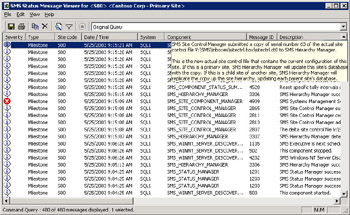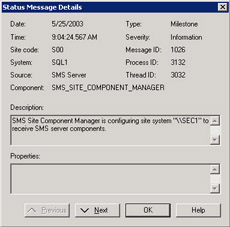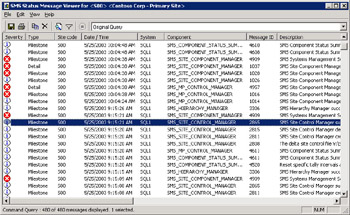| < Day Day Up > |
In the preceding chapters we’ve viewed log files and status messages as a way of interpreting and troubleshooting process flows and component activity in your Microsoft Systems Management Server (SMS) 2003 site. In this chapter we’ll spend a little more time exploring the uses of these tools, and we’ll look at some additional tools that will help you maintain your site. In particular, you’ll learn how to view status messages, use status summarizers, filter status messages, report status to other SMS components, and use queries to customize the status messages displayed. You’ll also learn how to use SMS Service Manager to start, stop, and monitor the status of the components as well as to enable logging and how to use the SMS Trace utility to view log files.
Virtually every SMS 2003 component and service generates status messages as it goes about its business. These messages aren’t the sometimes vague or unhelpful variety you might have come to dread in the Windows Event Viewer. On the contrary, SMS 2003 status messages are rich with details. In the event of error messages, the details often offer potential reasons for the error and suggest possible remedies.
Status messages represent the flow of process activity for each site system and client. They’re automatically consolidated and filtered for display using status summarizers and status filters (discussed in detail in the sections entitled “Understanding Status Summarizers” and “Filtering Status Messages” later in this chapter). As you’ll see throughout this book, these status messages will provide your first, and often best, insight into how a process or task works and what to do in the case of a problem.
There are three levels of severity for status messages in SMS 2003: informational, warning, and error. Informational messages are just that—informational. They simply record the fact of an event occurring, such as a service or component starting, the successful completion of a task, and so on. Warning messages are of concern, but they aren’t necessarily fatal to the site server’s operation. They generally indicate potential problems, such as low disk space, a component that failed or that is retrying a task, or a file that was corrupted. Error messages are usually of great concern, as they indicate problems that could harm the SMS site. These require the attention of the SMS administrator for resolution. Error messages include authentication problems, the complete failure of a service or component to complete a task, database access problems, and so on.
Every status message that’s generated will fall into one of three message type categories: milestone, detail, and audit. Milestone message types usually relate to the start or completion of a task. For example, a successful completion would generate a milestone informational message, whereas an unsuccessful task would generate a milestone warning or error message. Detail message types generally refer to the steps in a process and make sense only in the context of the status message process flow. Again, these might be informational, warning, or error messages, depending on the severity of the process steps being reported. Audit message types refer to objects being added, deleted, or modified in some way, usually by the SMS administrator—for example, assigning a site system role or modifying a collection membership.
You can view status messages through the System Status node in the SMS Administrator Console, as shown in Figure 5.1. From this node, you can view the advertisement status, the package status, and the component and site system status for the SMS site, and you can execute status message queries. We’ll discuss status messages for advertisements and packages as we get to those topics in Chapter 12, “Package Distribution and Management.”
Site status messages fall into two categories: component status and site system status. If all is well with your site, you should see a green check mark (an OK indicator) in front of each node, as you do for the Site System Status node in Figure 5.1. If any problems have been detected, this check mark might change to an x in a red circle (an Error indicator), as you see for the Site Status node in Figure 5.1, based on the thresholds you set. (For a detailed discussion of thresholds, see the section entitled “Status Message Thresholds” later in this chapter). The icons for OK, Warning, or Error will help you to determine which components need attention.
You will always begin troubleshooting by viewing the summary information. First select Component Status in the SMS Administrator Console to display a list of all SMS components and services and a summary of their current status, as shown in Figure 5.2. In the Component Status window, you can see at a glance the component status; the site system on which the component is running; the component name; its current state; the number of error, warning, and informational messages that have been generated; how the component wakes up (type); when a scheduled component next runs; the last time the component woke up; and the last time a message was written. In this case, we can see that while most components are running properly, the component—SMS_Site_ Component_Manager—has been elevated to Critical status.
| Tip |
Click the Show/Hide Console Tree icon (fifth from the right on the toolbar at the top of the SMS Administrator Console) to hide the console tree so that you can more easily view the Component Status window. |
Click the Site System Status node to display a list of all the site systems identified for the site and their summary status by site system role, as shown in Figure 5.3. In the Site System Status window, you can view the site system status, the site system name, the role that has been assigned to the site, the location of the storage object (partition and folder or database), total and free storage space, free space represented as a percentage of the total, and whether the system has been down. In this case, all site systems are running properly.
The detailed information behind each summary entry in the Component Status window pertains specifically to that component. However, the detailed messages behind each summary entry in the Site System Status window reference messages from any number of SMS components and services that are running on, or affect, that particular site system.
We examined how to view status messages in Chapter 3, “Configuring Site Server Properties and Site Systems”; let’s review here. To view the detailed messages for a specific component in the Component Status window, for example, for the SMS_Site_Component_Manager component in Figure 5.2 that indicates a critical status, follow these steps:
Right-click the component’s summary entry and choose Show Messages from the context menu to display a list of message types, as shown in Figure 5.4.
The All option displays all messages collected for this entry, Errors displays only error messages, Warnings displays only warning messages, and Info displays only info messages. For this example, choose Info. The Status Message Viewer appears, as shown in Figure 5.5.
To view a detailed description of the message, position the mouse pointer over the Description field to display a pop-up window, as shown in Figure 5.6.

Figure
5.6: A pop-up window containing a detailed description of a
status message.
Alternatively, you can double-click the message to display the Status Message Details dialog box, as shown in Figure 5.7. This dialog box provides you with more specific details about the message. It also provides buttons to enable you to view the previous and the following messages. For this example, click OK to close the dialog box.

Figure
5.7: The Status Message Details dialog box.
Close the Status Message Viewer when you’ve finished reviewing the message details.
To view the detailed messages for a site system in the Site System Status window, follow these steps:
Right-click a site system’s summary entry and choose Show Messages from the context menu to display a list of message types.
Choose All to display all messages collected for this entry, choose Errors to display only error messages, choose Warnings to display only warning messages, or choose Info to display only informational messages.
After you choose an option, the Set Viewing Period dialog box is displayed, as shown in Figure 5.8. Select the Specify Date And Time option to display only messages generated after the date and time you enter. Select the Select Date And Time option to display messages generated within a more generic time period from 1 hour ago to 1 year ago.
Click OK to display the Status Message Viewer, as shown in Figure 5.9. You can also click Skip if you prefer not to limit the scope of the messages displayed.

Figure
5.9: The Status Message Viewer for a site system status
window summary entry.
View the detailed description for each message either by positioning your mouse pointer on the message’s Description field to display a pop-up window or by double-clicking the message to display the Status Message Details dialog box.
Close the Status Message Viewer when you’ve finished reviewing the message details.
In this section we’ve discussed how to view status messages in the Status Message Viewer. We’ll continue to explore how to utilize this viewer in the next section.
When SMS components or services generate status messages, they’re written to the site database. The Status Message Viewer uses the SMS Provider to query the database for the detailed messages when you use the technique described in the preceding section.
As shown in Figure 5.9, the Status Message Viewer for the site system status displays all the SMS components that are running on that site system or that affect it in any way. These messages are the same as those displayed for each component in the Component Status window. For example, the highlighted SMS_Site_Control_Manager message in Figure 5.9 is the same as the message highlighted in Figure 5.6.
Regardless of whether you’re viewing component status or site system status, the Status Message Viewer always displays the following information:
Severity Specifies whether the message category is info, warning, or error
Type Specifies whether the message type is milestone, detail, or audit
Site Code Specifies the three-character site code of the site for which the message was generated
Date / Time Specifies the time and date stamp indicating when the message was generated
System Specifies the server name of the site system for which the message was generated
Component Specifies the name of the SMS component or service that generated the message
Message ID Specifies the numeric code related to the task performed by the SMS component or service that generated the message
Description Provides a detailed description of the message
The Status Message Viewer provides many features that can facilitate your analysis of messages. Let’s begin with some of the GUI features. You can change the sort order of each column simply by clicking the column header. Each column has three sort options: click once to sort from lowest to highest, click again to sort from highest to lowest, and click once again to return to the default column order. You can, of course, resize the columns by clicking the border between each column heading and dragging to make the column wider or narrower. You can also move the columns to customize the display simply by dragging and dropping a column header to a new position.
By right-clicking any message entry to display its context menu, you can copy it, delete it, or display its Status Message Details window. You can also set a filter for the Status Message Viewer or refresh all the messages from this menu. You can select multiple messages for copying, deleting, and printing by using the Windows Explorer Ctrl-click method.
The Status Message Viewer also provides a variety of options and features that are enabled through the menus on its menu bar. Because most of these settings are self-evident, we’ll look here only at those that are unique or of particular interest to the SMS administrator—in particular, the options in the Status Viewer Options dialog box and the Filter Status Messages window.
Let’s start by discussing the Status Viewer Options dialog box. Begin by displaying the Status Message Viewer for a component or site system. Choose Options from the View menu to display the Status Viewer Options dialog box shown in Figure 5.10. The General tab is shown by default.
The Status Message Viewer doesn’t refresh the interface with new messages by default unless you tell it to—for example, by pressing F5. The General tab lets you enable auto-refresh and specify a refresh interval. However, having the viewer automatically refresh itself will incur additional resource cost, so you shouldn’t select this option unless you intend to leave the viewer open for a long time—perhaps to follow the flow of a task or the generation of messages. You can also limit the number of messages that are collected and displayed.
| Caution |
The Status Message Viewer might not display data correctly when you execute it on the SMS Administrator Console running on Microsoft Windows XP Professional with no service pack applied and when your SMS site database or SMS Provider is on a server running Windows Server 2003. To ensure that the Status Message Viewer executes correctly, be sure to update the Windows XP Professional computer running the SMS Administrator Console with Service Pack 1 or higher. |
The Status Message Viewer displays messages stamped with the local time and date. The General tab lets you specify different time zones if you want to see when a message was generated on a site or site system in a different geographic location.
Most status messages are generated based on generic text strings in which variables have been inserted to customize the detail to a specific component, time, and so on. For example, message ID 4611 for the SMS Component Status Summarizer contains the text:
This message always reads the same, except that the percent values are replaced with a specific SMS component value and server value. Displayed in the Status Message Viewer for SMS Site Component Manager on site server SQL1, this message would read:
SMS Component Status Summarizer reset the status of component "SMS Site Component Manager", running on computer "SQL1", to OK.
If you clear the Resolve Description Strings and Resolve Property Strings check boxes in the General tab, the status messages would resolve more quickly but would leave empty quotation marks in the variable positions, rendering the messages not especially helpful to the SMS administrator.
The Columns tab of the Status Viewer Options dialog box, shown in Figure 5.11, enables you to customize the information displayed in the Status Message Viewer by adding columns to view thread and process IDs or by removing columns that might not be of interest.
By default, status messages are deleted after seven days, but you can adjust this setting to suit your needs. Because some components can generate a multitude of messages, you might decide to delete messages more frequently to better manage database space. If you need to save or copy status messages to file for future reference and analysis or to print them out, the Export tab of the Status View Options dialog box, shown in Figure 5.12, provides options for doing so.
The Exported Details frame lets you specify whether to include all possible data about a status message or only the data associated with the displayed columns. Under Information Delimiter, you can identify whether columns should be exported as tab delimited or comma delimited. This option is helpful if you expect to import this data into some other reporting or analysis tool such as Microsoft Excel or Microsoft Access. The Export Selection frame lets you specify whether to export only messages that you’ve selected in the viewer or all messages. By default, every time you choose to copy, print, or save a message, this Export tab is displayed, allowing you to modify the options before continuing. If you want the same options to apply to every copy, print, or save operation, clear the Force Selection Of Export Options For Each Export check box.
The Font tab, shown in Figure 5.13, enables you to set the typeface, style, and size of the font that will be used to display messages in the Status Message Viewer. Be careful to choose something readable. A decorative font might look pretty at first, but if you’ll be scrutinizing messages for long periods of time, a poorly chosen font can give you a headache.
Another neat feature of the Status Message Viewer is the set of filter options, which let you customize which messages are displayed in the Status Message Viewer. If you’ve used the filter options in the Windows Event Viewer, these filter options will be familiar. To set the filter options, choose Filter from the View menu to display the Filter Status Messages dialog box, as shown in Figure 5.14, or click the Filter icon from the tool bar (the one that looks like a funnel).
You can filter messages based on any status message detail. Figure 5.14 shows a filter that displays error messages of any type (milestone, detail, and audit) for site S00 and generated by the component SMS Site Backup on site system SQL1. Click the Advanced button to display the Advanced Filter Options dialog box, where you can also specify filtering based on Process ID and Thread ID, message properties, and a range of time.
| < Day Day Up > |